Exploring ‘The Land of Morning Calm’
New York Times
last updated: Oct 06,2022

Before
South Korea became globally known for its beauty products, kimchi, and pop
groups, it was known as the Land of the Morning Calm. The name has long been
used to refer to the Korean Peninsula, before the division of South and North
Korea, because of its tranquil, temple-dotted mountains and serene forests
where dawn breaks on the Asian mainland.اضافة اعلان
But calm is not a word that best captured the state of South Korea in the years running up to the pandemic. It experienced a cultural explosion of art, cuisine, literature, and cinema with high profile films such as Parasite, which swept the Oscars in February 2020 and nudged the nation onto many travelers’ maps. A month later, the coronavirus hit and a calm returned. The bustling nation had closed shop.
But on June 1, 2022, Korea opened to foreign tourists again, issuing short-term travel visas for the first time in two years, and lifted most COVID-related restrictions for residents.
The secrets of rural Korea are not widely known, even to many urbanite Koreans. According to urban planning statistics, 92 percent of the country’s population now lives in urban areas, up from 39 percent in 1960.
In March 2019, I spent two weeks hiking and touring through rural South Korea to explore the eight mainland provinces of this 100,362 sq.km. country. Unbeknownst to me, March was not the best time to go. It was mud season. Wildflowers had not yet bloomed, many trails were still closed, and the smog was at its worst.
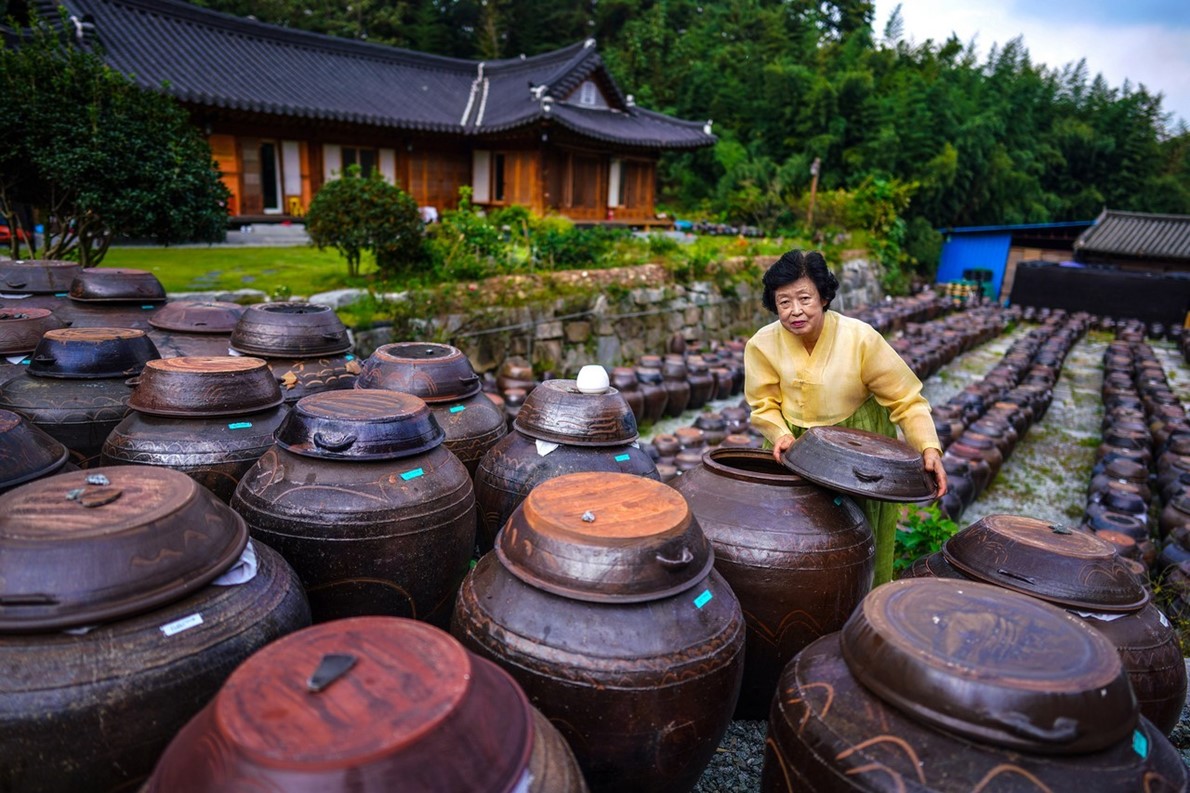
Ki Soon Do, a prestigious Grand Master of Jang, Korea’s traditional fermented sauces, with her jars in Changpyeong, South Korea. Jang is an essential ingredient to kimchi and many other Korean dishes.
Despite the mud, I lost myself in tranquil thatched-roof hamlets, peaceful Buddhist temples clinging to mountains, glittering dark sky reserves, and unhurried “slow food” towns where a generation of South Korean women older than 60 are preserving the country’s culinary heritage.
Leaving Seoul behind
South Korea’s northernmost province, Gangwon, two hours northeast of Seoul, is a sensible first stop, not to mention the scenic shooting locale for Okja, a 2017 movie by Parasite director Bong Joon Ho about a lovable pig raised on a lush mountaintop farm. Gangwon is pressed up against the infamous DMZ (Demilitarized Zone), a roughly 250km-long, 4km-wide buffer zone between North Korea and South Korea.
I skipped the DMZ to instead explore the northernmost parts of South Korea, where domestic travelers have long sought out pristine beaches, granite-peaked national parks, and forested valleys.
I was headed for Seoraksan (Snow Rock Mountain), one of South Korea’s 21 national parks and a UNESCO-listed Biosphere Reserve in the Taebeak Mountains, a spine running the length of the Korean Peninsula. At the park’s base is a smattering of gift shops and food stalls hawking hot coffee, noodle soups, and fortifying bowls of dok boki, toothsome rice cakes drenched in a fermented red chili sauce.
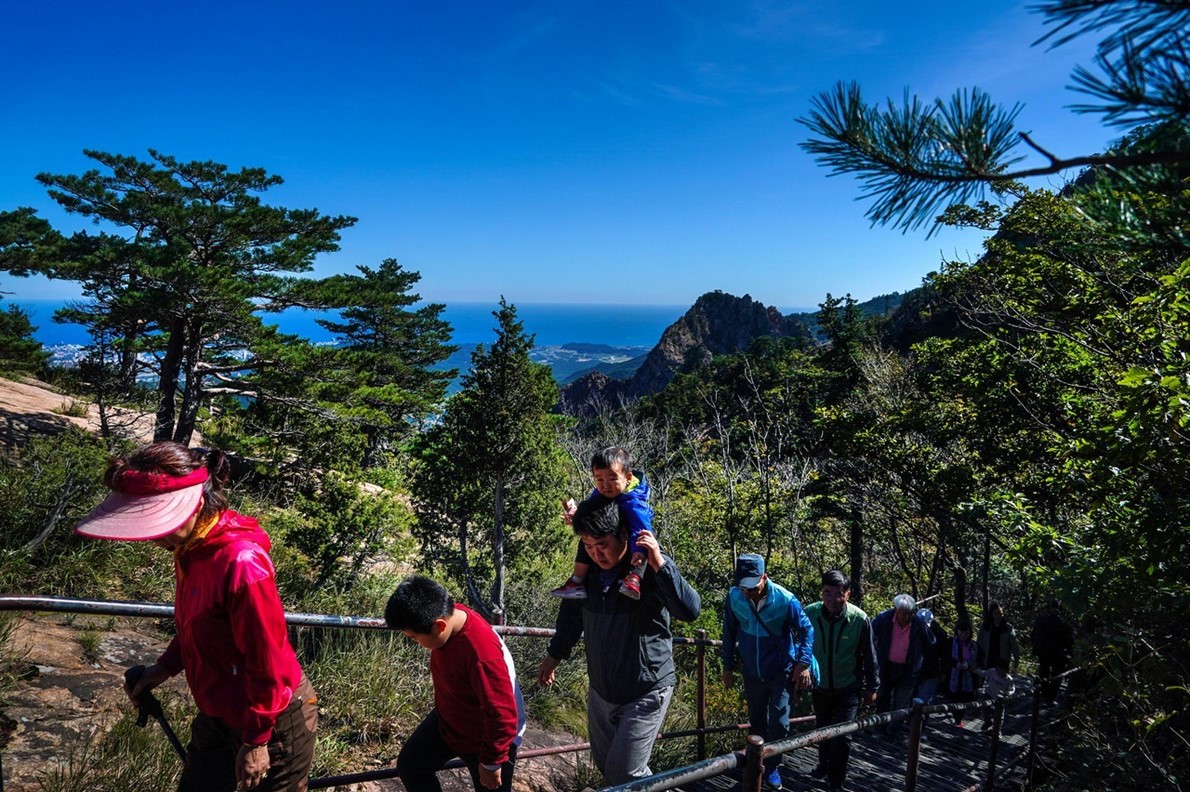
Visitors hike from a cable car to Gwongeum Fortress inside Seoraksan National Park in South Korea, October 9, 2019. Gwongeum Fortress was originally built to fend off the Mongolians, whose multiple 13th-century invasions left many traces in Korean art, cuisine, and culture as we know it today.
If you have a spare eight to 11 hours, you could make the challenging climb up 5,604 feet to Daecheong Peak, the park’s highest summit. I didn’t. Like most visitors, I opted instead for the shorter and easier cable car ride to another summit called Gwongeum Fortress, originally built to fend off the Mongolians, whose multiple 13th-century invasions left many traces in Korean art, cuisine, and culture as we know it today.
A Buddhist temple stay
At Seoraksan (and for much of my trip), I was the only non-Asian in the crowd, with no other international tourists in sight. But my next stop not only lacked other tourists, it had no other guests at all. At the 1,000-year-old Samhwasa, a temple hidden deep in a ravine in the Muneung Valley where I had booked a temple stay, I had the grounds to myself except for Bubchang, a sweet, wiry Buddhist monk wearing a heather gray robe, a floppy cap, and a permanent smile.
Bubchang walked with me in golden-hour light through mossy woods awash in pink spring wildflowers aside waterfalls trickling over weathered rocks, into which old poems were carved.
While ringing the bronze temple bell after our humble supper of rice and kimchi, Bubchang held my hand and told me that I was beautiful. Samhwasa’s temple stay program is called “Love Myself and Help Five Friends”.
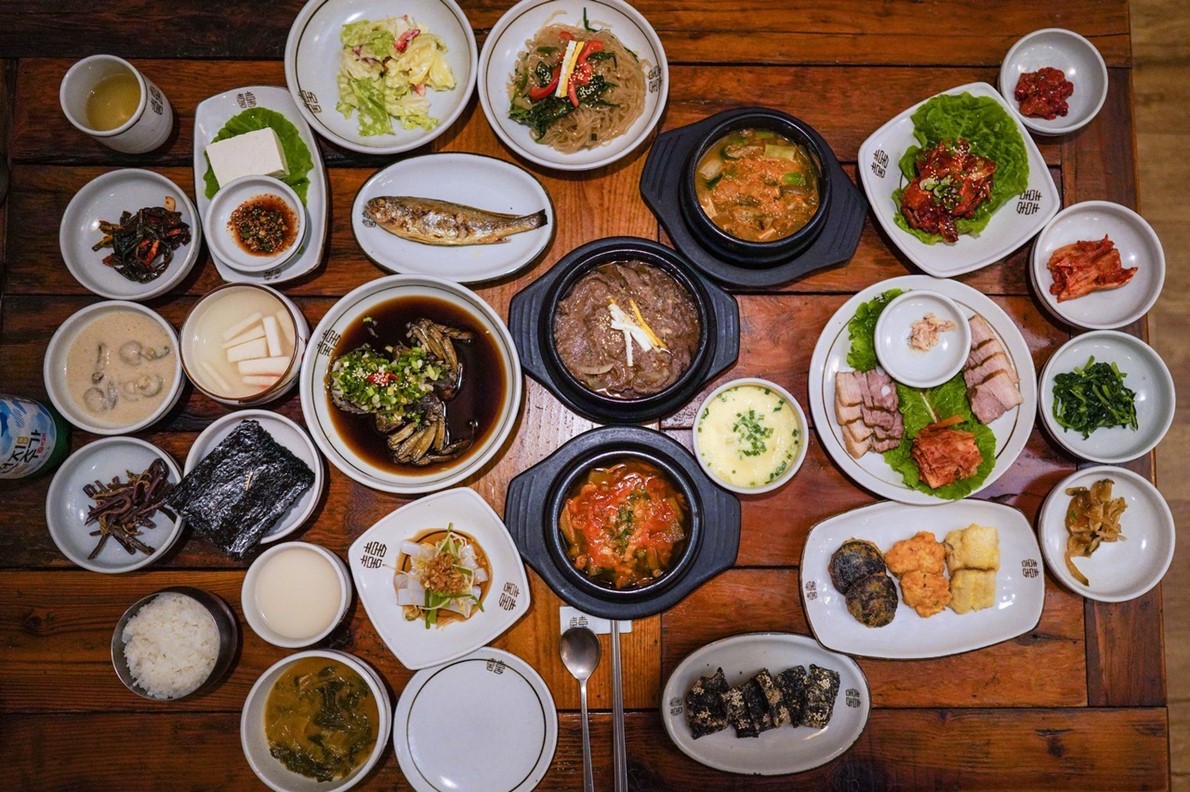
A dinner for two at Yangbanga at Jeonju Hanok Village in Jeonju, South Korea. Jeonju was chosen by UNESCO as a Creative City of Gastronomy in 2012.
“Visitors here learn to love themselves and then envision how they can help five friends,” says Bubchang, taking a selfie of us with his smartphone.
Although it was cold, smoggy, and raining for much of my visit in South Korea, I still made a point to visit Gangwon’s renowned beaches. Chuam Beach, just south of Korea’s easternmost city of Donghae, is a chill surf town famous for its pine-secluded beaches and sacred Chuam Chotdaebawi Rock, named for candle-shaped sea stacks. Local myth says the stacks represent a man who couldn’t choose between his wife and concubine, so all three of them were petrified.
Onward to a hanok
Korea’s hanoks, traditional guesthouses, are another way to experience old Korea, and many have been meticulously preserved and are worth seeking out. I continued south by car for two hours to reach the Gyeongsangbuk province, home to the Andong Hahoe Hanok Village nestled into a flat and sandy ox bow of the Nakdong River. Most of the low-slung houses lining the stonewalled, earthen lanes have landscaped courtyards, thatched roofs, and sliding windows covered with hanji, a fibrous paper made from mulberry bark and used in many traditional houses.
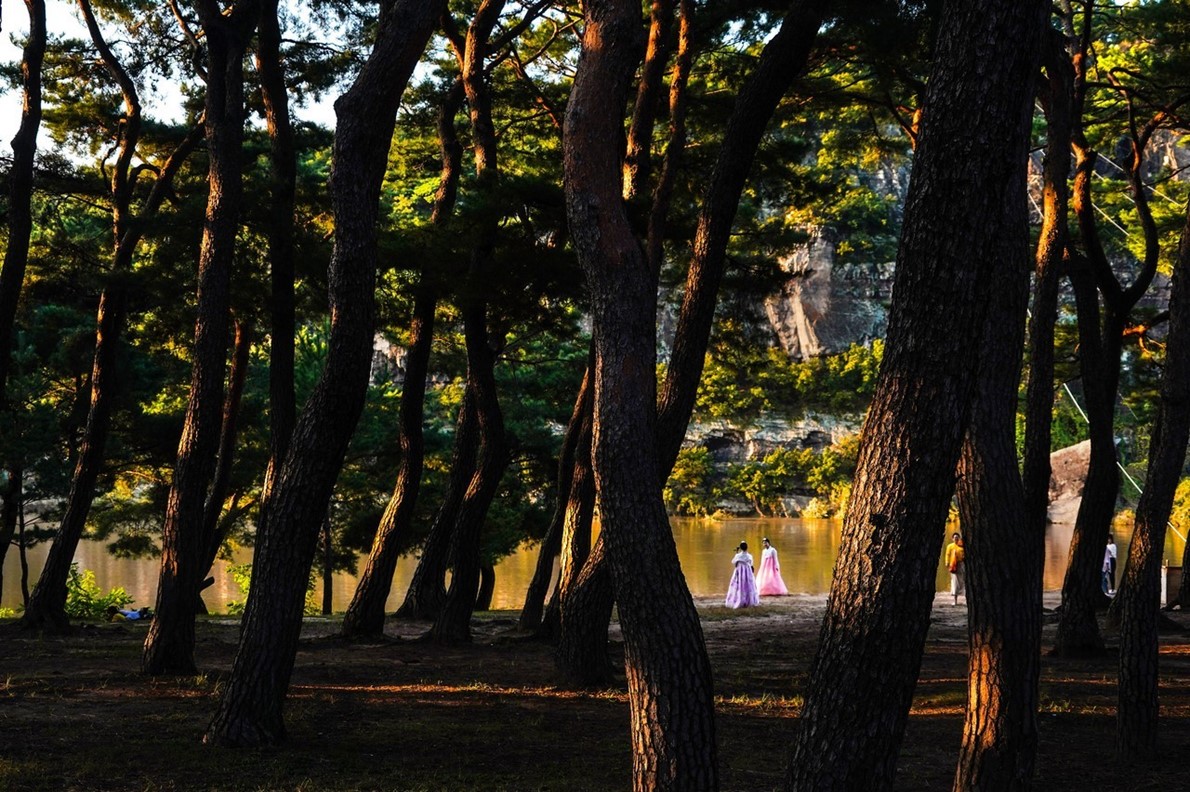
At the village center is Bukchondaek House, built for a noble family in 1811 and converted to a hanok in 2016. It was wrapped in verandas and shaded by a gnarly 300-year-old pine tree. Its ninth-generation owners had meticulously restored the painted screens and heated ondol floors, a system using smoke from a subterranean fire, while the hand-woven cotton wool mattresses were beautiful, but made me yearn for something a bit thicker.
But what it cost me in sleep, it made up for in charm. At sunset, I walked through the village’s sandy-floored pine forests and spied a pair of stout water deer running through the riverbed’s rustling reeds.
Slow food along the southern coast
A two-hour drive southwest took me past scraggly mountain forests to the lush, hilly seashores of North and South Jeolla along the country’s southern coast, including 2,000 islands (300 of which are uninhabited). No place in South Korea better expresses the nation’s devotion to food than these green, relaxed, and lesser-developed provinces.
This is the home of Baekyangsa Temple, introduced to many foodies in an episode of the Netflix show Chef’s Table featuring Buddhist nun Jeong Kwan, whose temple cooking includes lotus-scented water and acorns brushed with sesame oil. But she isn’t the only one known for cooking here. Slow Food International, an Italian-based organization focused on preserving local food heritage, has nominated a handful of “cittaslow” (slow cities) in Jeolla for their time-honored cuisine, and local female food experts are often at the center of them.

It was pouring rain when I arrived in the slowcitta of Jeonju, chosen by UNESCO as a Creative City of Gastronomy in 2012. The cobbled main street is lined with reproduction Joseon-era storefronts bustling with street food vendors hawking everything from grapefruit beer to grilled cheese sandwich skewers.
A few blocks away, hidden behind a gated garden, was my next hanok, Hakindang House (rooms from $75), a property built of wide planks of sturdy black pine by royal palace carpenters in 1908. Exhausted after a day of travel, I climbed onto the thin mattress in my guest room and fell asleep listening to the pitter-patter of rain on the clay roof.
In the morning, I was greeted by Seo Hwa-soon, the great-great-granddaughter of the house’s founder (she has since retired). In 1950s-style red frame glasses and a fastidiously tied pink silk scarf, she served me an epic breakfast of 25 colorful and meticulously arranged dishes, including traditional family recipes like saenghapjak made with julienne white lilies, shiitake, and carrots; pink-dyed lotus root slices; and gloriously tender bulgogi: grilled Korean beef.

My last stop was the slowcitta of Changpyeong, known for its stonewalled lanes and relaxed cafes and shops serving hangwa — confections sweetened with honey. It is also home to Ki Soon-do, the prestigious Grand Master of Jang, Korea’s traditional fermented sauce (an essential ingredient to kimchi), and many other Korean dishes.
In the front yard of Ki’s woodsy home studio were dozens of hangari (clay pots) brimming with fermenting jangs including ganjang (soy sauce), a miso-like paste called doenjang, and the spicy-red-pepper-based gochujang, which she makes with strawberries, her house specialty.
Her family has been making these sauces for 10 generations and now ship the jangs globally. Wearing a traditional green and gold hanbock dress, Ki played the role of matriarch with aplomb. She checked the sauces with a spoon made from a hollowed-out gourd. Her adult son watched her face closely while she took a taste, understanding that her palate is the family’s most valuable asset.
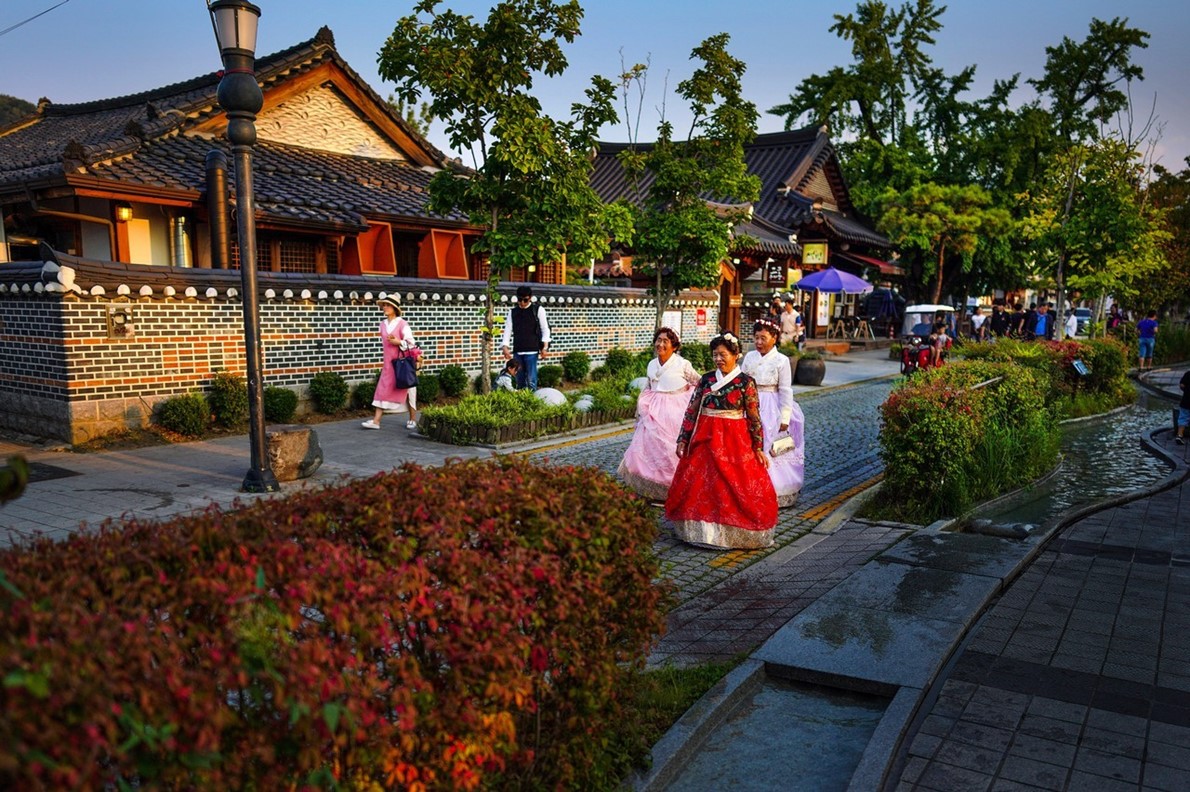
Back in the city there would be plenty of malls, museums, and modern hotels, from the midrange Lotte to the luxurious Four Seasons. But it is harder to find Old Korea there. Like many city-dwellers around the world, Seoulites developed a deeper love for nature and escaping the city during the pandemic. Perhaps access to rural areas will open up more as foreign tourism increases.
“Foreigners are only beginning to understand Korea and Korean food,” Ki had told me, as she stirred a 20-year-old pot of jang. “We want to share it with the world as a way to help preserve these old traditions.”
Read more Travel
Jordan News
But calm is not a word that best captured the state of South Korea in the years running up to the pandemic. It experienced a cultural explosion of art, cuisine, literature, and cinema with high profile films such as Parasite, which swept the Oscars in February 2020 and nudged the nation onto many travelers’ maps. A month later, the coronavirus hit and a calm returned. The bustling nation had closed shop.
But on June 1, 2022, Korea opened to foreign tourists again, issuing short-term travel visas for the first time in two years, and lifted most COVID-related restrictions for residents.
The secrets of rural Korea are not widely known, even to many urbanite Koreans. According to urban planning statistics, 92 percent of the country’s population now lives in urban areas, up from 39 percent in 1960.
In March 2019, I spent two weeks hiking and touring through rural South Korea to explore the eight mainland provinces of this 100,362 sq.km. country. Unbeknownst to me, March was not the best time to go. It was mud season. Wildflowers had not yet bloomed, many trails were still closed, and the smog was at its worst.

Ki Soon Do, a prestigious Grand Master of Jang, Korea’s traditional fermented sauces, with her jars in Changpyeong, South Korea. Jang is an essential ingredient to kimchi and many other Korean dishes.
Despite the mud, I lost myself in tranquil thatched-roof hamlets, peaceful Buddhist temples clinging to mountains, glittering dark sky reserves, and unhurried “slow food” towns where a generation of South Korean women older than 60 are preserving the country’s culinary heritage.
Leaving Seoul behind
South Korea’s northernmost province, Gangwon, two hours northeast of Seoul, is a sensible first stop, not to mention the scenic shooting locale for Okja, a 2017 movie by Parasite director Bong Joon Ho about a lovable pig raised on a lush mountaintop farm. Gangwon is pressed up against the infamous DMZ (Demilitarized Zone), a roughly 250km-long, 4km-wide buffer zone between North Korea and South Korea.
I skipped the DMZ to instead explore the northernmost parts of South Korea, where domestic travelers have long sought out pristine beaches, granite-peaked national parks, and forested valleys.
I was headed for Seoraksan (Snow Rock Mountain), one of South Korea’s 21 national parks and a UNESCO-listed Biosphere Reserve in the Taebeak Mountains, a spine running the length of the Korean Peninsula. At the park’s base is a smattering of gift shops and food stalls hawking hot coffee, noodle soups, and fortifying bowls of dok boki, toothsome rice cakes drenched in a fermented red chili sauce.

Visitors hike from a cable car to Gwongeum Fortress inside Seoraksan National Park in South Korea, October 9, 2019. Gwongeum Fortress was originally built to fend off the Mongolians, whose multiple 13th-century invasions left many traces in Korean art, cuisine, and culture as we know it today.
If you have a spare eight to 11 hours, you could make the challenging climb up 5,604 feet to Daecheong Peak, the park’s highest summit. I didn’t. Like most visitors, I opted instead for the shorter and easier cable car ride to another summit called Gwongeum Fortress, originally built to fend off the Mongolians, whose multiple 13th-century invasions left many traces in Korean art, cuisine, and culture as we know it today.
A Buddhist temple stay
At Seoraksan (and for much of my trip), I was the only non-Asian in the crowd, with no other international tourists in sight. But my next stop not only lacked other tourists, it had no other guests at all. At the 1,000-year-old Samhwasa, a temple hidden deep in a ravine in the Muneung Valley where I had booked a temple stay, I had the grounds to myself except for Bubchang, a sweet, wiry Buddhist monk wearing a heather gray robe, a floppy cap, and a permanent smile.
Bubchang walked with me in golden-hour light through mossy woods awash in pink spring wildflowers aside waterfalls trickling over weathered rocks, into which old poems were carved.
While ringing the bronze temple bell after our humble supper of rice and kimchi, Bubchang held my hand and told me that I was beautiful. Samhwasa’s temple stay program is called “Love Myself and Help Five Friends”.

A dinner for two at Yangbanga at Jeonju Hanok Village in Jeonju, South Korea. Jeonju was chosen by UNESCO as a Creative City of Gastronomy in 2012.
“Visitors here learn to love themselves and then envision how they can help five friends,” says Bubchang, taking a selfie of us with his smartphone.
Although it was cold, smoggy, and raining for much of my visit in South Korea, I still made a point to visit Gangwon’s renowned beaches. Chuam Beach, just south of Korea’s easternmost city of Donghae, is a chill surf town famous for its pine-secluded beaches and sacred Chuam Chotdaebawi Rock, named for candle-shaped sea stacks. Local myth says the stacks represent a man who couldn’t choose between his wife and concubine, so all three of them were petrified.
Onward to a hanok
Korea’s hanoks, traditional guesthouses, are another way to experience old Korea, and many have been meticulously preserved and are worth seeking out. I continued south by car for two hours to reach the Gyeongsangbuk province, home to the Andong Hahoe Hanok Village nestled into a flat and sandy ox bow of the Nakdong River. Most of the low-slung houses lining the stonewalled, earthen lanes have landscaped courtyards, thatched roofs, and sliding windows covered with hanji, a fibrous paper made from mulberry bark and used in many traditional houses.

At the village center is Bukchondaek House, built for a noble family in 1811 and converted to a hanok in 2016. It was wrapped in verandas and shaded by a gnarly 300-year-old pine tree. Its ninth-generation owners had meticulously restored the painted screens and heated ondol floors, a system using smoke from a subterranean fire, while the hand-woven cotton wool mattresses were beautiful, but made me yearn for something a bit thicker.
But what it cost me in sleep, it made up for in charm. At sunset, I walked through the village’s sandy-floored pine forests and spied a pair of stout water deer running through the riverbed’s rustling reeds.
Slow food along the southern coast
A two-hour drive southwest took me past scraggly mountain forests to the lush, hilly seashores of North and South Jeolla along the country’s southern coast, including 2,000 islands (300 of which are uninhabited). No place in South Korea better expresses the nation’s devotion to food than these green, relaxed, and lesser-developed provinces.
This is the home of Baekyangsa Temple, introduced to many foodies in an episode of the Netflix show Chef’s Table featuring Buddhist nun Jeong Kwan, whose temple cooking includes lotus-scented water and acorns brushed with sesame oil. But she isn’t the only one known for cooking here. Slow Food International, an Italian-based organization focused on preserving local food heritage, has nominated a handful of “cittaslow” (slow cities) in Jeolla for their time-honored cuisine, and local female food experts are often at the center of them.

It was pouring rain when I arrived in the slowcitta of Jeonju, chosen by UNESCO as a Creative City of Gastronomy in 2012. The cobbled main street is lined with reproduction Joseon-era storefronts bustling with street food vendors hawking everything from grapefruit beer to grilled cheese sandwich skewers.
A few blocks away, hidden behind a gated garden, was my next hanok, Hakindang House (rooms from $75), a property built of wide planks of sturdy black pine by royal palace carpenters in 1908. Exhausted after a day of travel, I climbed onto the thin mattress in my guest room and fell asleep listening to the pitter-patter of rain on the clay roof.
In the morning, I was greeted by Seo Hwa-soon, the great-great-granddaughter of the house’s founder (she has since retired). In 1950s-style red frame glasses and a fastidiously tied pink silk scarf, she served me an epic breakfast of 25 colorful and meticulously arranged dishes, including traditional family recipes like saenghapjak made with julienne white lilies, shiitake, and carrots; pink-dyed lotus root slices; and gloriously tender bulgogi: grilled Korean beef.

My last stop was the slowcitta of Changpyeong, known for its stonewalled lanes and relaxed cafes and shops serving hangwa — confections sweetened with honey. It is also home to Ki Soon-do, the prestigious Grand Master of Jang, Korea’s traditional fermented sauce (an essential ingredient to kimchi), and many other Korean dishes.
In the front yard of Ki’s woodsy home studio were dozens of hangari (clay pots) brimming with fermenting jangs including ganjang (soy sauce), a miso-like paste called doenjang, and the spicy-red-pepper-based gochujang, which she makes with strawberries, her house specialty.
Her family has been making these sauces for 10 generations and now ship the jangs globally. Wearing a traditional green and gold hanbock dress, Ki played the role of matriarch with aplomb. She checked the sauces with a spoon made from a hollowed-out gourd. Her adult son watched her face closely while she took a taste, understanding that her palate is the family’s most valuable asset.

Back in the city there would be plenty of malls, museums, and modern hotels, from the midrange Lotte to the luxurious Four Seasons. But it is harder to find Old Korea there. Like many city-dwellers around the world, Seoulites developed a deeper love for nature and escaping the city during the pandemic. Perhaps access to rural areas will open up more as foreign tourism increases.
“Foreigners are only beginning to understand Korea and Korean food,” Ki had told me, as she stirred a 20-year-old pot of jang. “We want to share it with the world as a way to help preserve these old traditions.”
Read more Travel
Jordan News

